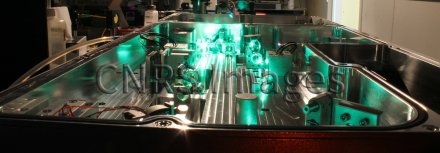Production year
2014

© Thibaut SYLVESTRE/Femto-ST/CNRS Images
20140001_1986
Oscillateur paramétrique optique (OPO), une source de lumière cohérente et monochromatique. La lumière émise par un OPO peut s'étendre de l'ultra-violet au moyen infrarouge, de façon continue ou selon des impulsions de durée variable. La couleur émise représente la fluorescence paramétrique du cristal à l'intérieur de l'OPO. Elle varie en fonction de l'orientation de ce cristal. Un OPO est principalement utilisé pour produire des longueurs d'onde, là où les lasers font défaut. Il trouve notamment des applications dans des expériences de physique, lorsqu'une longueur d'onde bien précise est nécessaire.
The use of media visible on the CNRS Images Platform can be granted on request. Any reproduction or representation is forbidden without prior authorization from CNRS Images (except for resources under Creative Commons license).
No modification of an image may be made without the prior consent of CNRS Images.
No use of an image for advertising purposes or distribution to a third party may be made without the prior agreement of CNRS Images.
For more information, please consult our general conditions
2014
Our work is guided by the way scientists question the world around them and we translate their research into images to help people to understand the world better and to awaken their curiosity and wonderment.